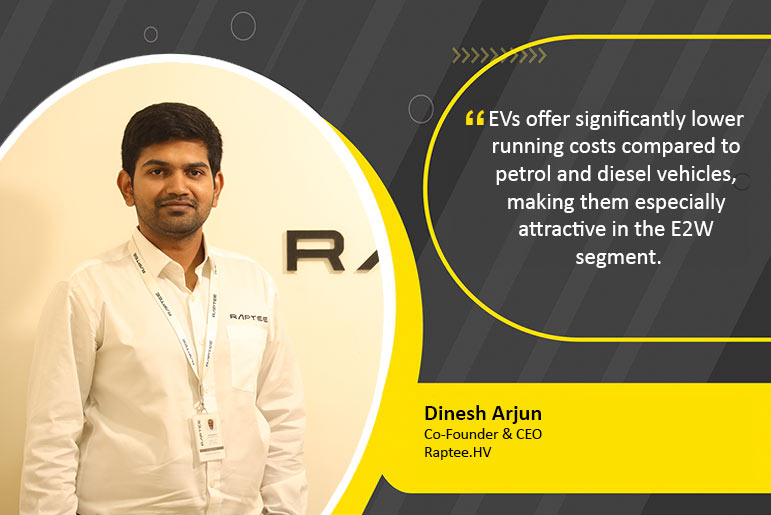The adoption of electric vehicles (EVs) in India is no longer a fringe phenomenon; it is rapidly transforming into a mainstream movement. With over 36.39 lakh EV registrations over the last 5 years, contributing 3.38% to the total vehicle market, India is making commendable strides in embracing sustainable mobility. This momentum is being driven by an evolving landscape, offering unprecedented opportunities for stakeholders, from consumers to businesses, and signaling a transformative shift in the nation’s transportation ecosystem.
Adoption of EVs: The Indian Narrative
Rural and Metro Perspectives in the E2W Segment
In rural India, the adoption of electric two-wheelers (E2Ws) is gaining traction, primarily driven by lower operational costs compared to internal combustion engine (ICE) vehicles. Farmers, small business owners, and daily commuters are beginning to see EVs as a cost-effective and reliable alternative for daily transportation. Metro cities, on the other hand, are witnessing a surge in E2W adoption due to increased awareness of environmental concerns, rising fuel costs, and the convenience of navigating urban traffic with compact, efficient electric scooters and bikes.
Adoption in Tier-1, Tier-2, and Tier-3 Cities
Adoption patterns differ significantly across urban tiers. Tier-1 cities like Bengaluru, Pune, and Delhi are leading the EV charge due to better charging infrastructure, higher disposable incomes, and a tech-savvy population. Tier-2 cities such as Jaipur and Coimbatore are catching up as public awareness rises and infrastructure improves. Even Tier-3 cities are not far behind; affordability and government incentives are encouraging early adopters to consider electric alternatives.
Driving Factors Behind Adoption
Three major factors contribute to the growing adoption of EVs in India: cost efficiency, government support, and increased awareness.
EVs offer significantly lower running costs compared to petrol and diesel vehicles, making them especially attractive in the E2W segment. Government initiatives such as the Faster Adoption and Manufacturing of Hybrid and Electric Vehicles (FAME) scheme, PLI-Auto Scheme, and PM E-DRIVE have lowered barriers to entry by incentivizing both buyers and manufacturers.
Recent Adoption Trends
The adoption of electric vehicles (EVs) in India is gaining momentum across segments. Electric two-wheelers (E2Ws) have seen their adoption rate rise from 4.4% in FY 2023 to 6.6% as of August 2024, reflecting growing consumer interest in affordable and efficient commuting options.
The penetration rate of electric scooters (e-scooters) in India has already reached 15% and it could account for 20-25% of the total scooter market by FY26. Also, the penetration rate for electric motorcycles in India is currently negligible as of 2024. This segment is expected to grow rapidly and is expected to reach double digits in the next 5 -10 years.
Similarly, electric three-wheelers (E3Ws) now boast adoption rates of 21.3% for passenger vehicles and 20.7% for goods carriers, bolstered by a remarkable 20% year-on-year sales growth in October 2024.
The sales of electric four-wheelers saw a significant increase of 73% in October 2024, rising to 10,561 units compared to 6,097 units in September 2024.
The Evolving Landscape of EVs
The Indian EV industry is witnessing exponential growth, marked by increasing diversity in brands and products.
Rising Number of Players
Both startups and established corporates are investing heavily in EV technology. From legacy players to agile startups, the competition is intensifying. Big brands are offering a wide array of choices at different price points across various market segments, while smaller players are focusing on innovative technologies to stay competitive in the market.
Expanding Consumer Choices
EVs today cater to a wide range of preferences and budgets. Consumers now have the flexibility to choose vehicles tailored to their specific needs. For instance, charging options range from fast chargers that offer convenience to slow chargers that ensure affordability and longevity of battery life. Battery capacities and pricing are available across various use cases, accommodating everything from short commutes to long-distance travel. Additionally, battery swapping provides a unique solution for quick refuelling in urban and semi-urban areas. This variety empowers consumers to make informed decisions, further fueling the adoption of EVs.
Opportunities in India’s EV Ecosystem
India’s EV market is projected to reach a valuation of ₹20 lakh crore by 2030, creating employment for approximately 5 crore individuals. Several factors make India a fertile ground for EV growth.
Expanding Public Charging Infrastructure
India currently hosts 16,344 charging stations with 27,471 charging points, of which 10,756 are fast-charging points. While commendable, the demand for public charging infrastructure is set to grow exponentially as adoption accelerates. Expanding this infrastructure remains a crucial opportunity for both public and private sector investment.
Matching or Surpassing ICE Vehicle Performance
Modern EVs are increasingly meeting or exceeding the performance benchmarks set by ICE vehicles. High-torque motors and advanced drivetrains are offering exhilarating rides without compromising energy efficiency. EVs have evolved from merely eco-friendly alternatives to aspirational performance machines.
Innovative Designs
EV manufacturers are breaking free from the traditional ICE aesthetics, offering sleek, aerodynamic, and premium designs that redefine the visual and functional appeal of two-wheelers. These designs not only enhance performance but also differentiate EVs as sophisticated, modern machines.
Rising Fuel Costs
With petrol and diesel prices steadily increasing, the case for EVs as economical long-term solutions is more compelling than ever. This is especially significant in budget-conscious rural and semi-urban areas.
Falling Battery Prices
Battery technology continues to advance, driving down costs. With batteries constituting a significant portion of an EV’s price, these reductions directly translate into more affordable EVs for the average consumer.
Smarter Vehicles
More EV brands are integrating software features such as AI-driven performance optimization, predictive maintenance, and intuitive infotainment systems. These features not only enhance usability but also create new benchmarks for what a vehicle can do beyond traditional functionalities.
The Road Ahead
India stands at the forefront of an EV revolution. With rapid growth in sales, government support, and continuous innovation, the nation is poised to redefine mobility. By fostering collaboration across all stakeholders, India can shape a sustainable, inclusive, and electrified transportation future.


